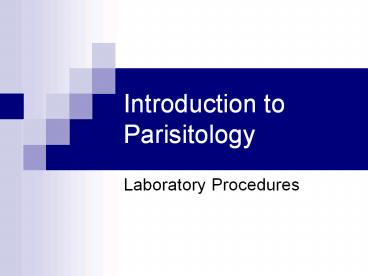Introduction to Parisitology PowerPoint PPT Presentation
1 / 32
Title: Introduction to Parisitology
1
Introduction to Parisitology
- Laboratory Procedures
2
(No Transcript)
3
Parasite
- A smaller organism that lives on or in and at the
expense of a large organism called the host. - Hosts expense may be trivial, substantial, or
even unbearable. - Hosts expense is dependant upon
- Number of parasites
- Kind and degree of the injury that they inflict
- Vigor or nourishment of the host
4
Parasitism
- Infestation with parasites
- Muliple parasitism A condition in which
parasites of different species parasitize a
single host - Superparasitism Excessive parasitization of the
same species.
5
Types of Relationships in Nature
- Mutualism
- Commensalism
- Predator-Prey
- Parasite
6
Mutualism
Both parties benefit equally in the relationship,
sometimes unable to exist without each other.
7
Commensalism
Relationship in which one population (or
individual) is benefited and the other is neither
benefited nor harmed.
8
Predator-Prey
9
Parasitic
Relationship in which one population (or
individual) adversely affects another, but cannot
life without it.
10
Life Cycles and Transmission of Parasites
- Life cycle describes how an organism develops
from the immature stage to the adult. - Some animals produce live young and others
produce eggs - Some one-celled parasites may even reproduce by
dividing into two identical parts
11
Direct Life Cycle
- The immature form of the parasite can infect the
same host it came from - Ex. Roundworms
12
Indirect Life Cycle
- The immature form must pass through a different
type of host before it can re-enter and infect he
host it came from. - Intermdiate host is the host in which the
immature form of the parasite lives - Definitive host is the host in which the adult
form lives. - Ex. Heartworms
13
(No Transcript)
14
Transport Hosts
- Some life cycles incorporate a transport host
- Is an intermediate host where no development
occurs. - Is a way for the parasite to get from one host to
another. - Rodents can transport roundworms to dogs and cats
15
Migration
- Many parasites have life cycles that include a
phase of migrating through the body. - Ex. Hookworms
16
Zoonoses
- Infections that can be passed from animals to
humans - Sometimes humans will have same symptoms of dog
and cat - Ex. Roundworms, Hookworms, Toxoplasma
17
Prepatent Period
- The time interval between when the parasite
enters the host and the subsequent form of the
parasite can be recovered from the host. - Ex Heartworms is 6 months
- Ex. Whipworms is three months
18
Incubation Period
- Represents the time from when the parasite enters
the host and the development of signs or symptoms
of disease. - Usually longer than prepatent period
19
Living arrangements of parasites
- Ectoparasites parasites that live outside the
host - Fleas, ticks
- Endoparasites parasites that live within the
host - Roundworms, heartworms, tapeworms
20
Obligatory Parasites
- Live on host at all times
- Can not live or reproduce in free environment
- Most parasites are obligatory in nature
- If live outside host, do in a dormant way until
get into a new host
21
Periodic Parasites
- Parasites that live part of their lives on a host
and part of it off the host. - Ticks
22
Facultative Parasites
- Parasites that can eat, sleep and lay eggs off
the host - May take opportunity to infect host if one
presents itself.
23
Major Classes of Parasites
- Helminths
- Nematodes (Roundworms)
- Cestodes (Tapeworms)
- Trematodes (Flukes)
- Arthropods
- Insects
- Arachnids
- Protozoa
24
Helminths
- Generic word for worm
- Is actually the grouping together of nematodes,
tapeworms, and flukes
25
Nematodes
- In general are round in cross section, longer
than they are wide and are unsegmented. - Can be in a variety of lengths.
- Significant cause of disease in dogs and cats
- Have varied life cycles
- Example is Roundworms
26
Tapeworms
- Flat worms that are segmented
- Head usually has suckers or muscular grooves that
enable it to attach itself to the animals
intestine - Each segment has own reproductive organs.
- Have no digestive system
- Life cycle includes an intermediate host
27
Flukes
- Flat, leaf shaped, unsegmented worms that look
similar to leeches. - Have suckers, hooks, or clam-like appendages
which they attach themselves to hosts organs. - Fluke eggs have a trap door called an operculum
- Dog and cat flukes have indirect life cycles
- Generally do not cause serious issues in dogs and
cats unless in high numbers
28
(No Transcript)
29
Arthropods
- Means joint foot and refers to fact that all
members have jointed legs - Include insects and arachnids
30
Insects
- Make up to 70 of all known species of animals of
all kinds - Have antennae, compound eyes and body
- Many have wings
- Fleas and lice
31
Arachnids
- Include ticks and mites
- Are carnivores by feeding on tissue and blood.
32
Protozoa
- Over 450,000 species of Protozoa
- Composed of nucleus and cytoplasm
- May move with assistance of flagella.
- Giardia is an example of a protozoa

